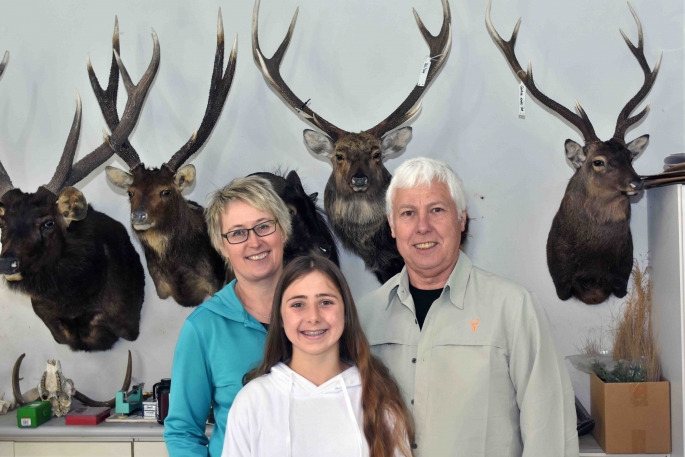Many a tale has been told; how the element of surprise was used to the best advantage and then ‘that’ shot – the moment dreams turn into reality. The thrill of the hunt!
For most it ends there, out in the wilderness – but for husband-and-wife team Vern and Louise Pearson, of Sika Country Taxidermy in Taupo, this is where their journey begins.
For Vern, his upbringing was typical of many young rural men; being outside with an air rifle in tow, shooting birds. His interest of hunting grew and keeping some of these early trophies signaled the beginning of his first days of taxidermy.
“I remember as early as Standard Two I was shooting with a slug gun. Taxidermy started for me then – injecting the wings of birds with formaldehyde.”
Louise was a different story, hailing from Denmark she completed a degree based around museum work, which initially piqued her interest. “Taxidermy in Denmark meant doing a four-year apprenticeship, which I couldn’t get into – it was hard to find this kind of work,” says Louise.
“Here in New Zealand, we started our business and never looked back.”
And with more than 50 years’ combined experience between them, and a business that’s been operating since 1989, the phone rings regularly. “We can get calls pretty soon after a hunt,” says Louise.
“Our customers understand how busy we are and once they let us know, we add them to the schedule. We might not see them for a month or two, but it gets them on the list.”
Waiting list
The service and skills of the Pearson’s are in hot demand; hence the schedule now being to the point they’re working with a waiting list of up to a year.
Once the skin and head of a species arrive, they are allocated a number and filed. The heads sit in the rafters of the workshop until it’s time to start recreating and skins are stored in a big walk-in freezer.
Louise says when each animal arrives, it needs to be assessed. “Everything is hunted differently, with different calibers, and with varying levels of damage.”
Skins, when removed, need to be pliable, so are water-blasted. This hydrates them to try and soften them up so they can be worked around a form.
“We need them to be pliable enough to be stretched and wrapped around a form, which is one of the various molds we use,” says Vern.
All game is put together differently, with variations between body size and shape, horns or antlers and muscle structures. All of these differences have to be taken into account to get a good result. Identifying this and making a mold to suit each one is part of each job.
“The mold is made from polyurethane foam, which we manipulate and carve to get the correct muscle definition for mounting,” says Vern.
“The thickness of the skin is important to this process and we sometimes need to shave this down and get it thin enough to show that definition. A buffalo, for instance, will have a skin about 25mm thick and we get that down to 5mm.”
The skin is glued to the mold and the features rebuilt. The final touches include building the key parts of the face and head – the eyes, nose, etc. These are finally airbrushed to get the detail required.
Even with all of work this taken into account, the Pearsons still manage to taxidermy anywhere from 180-225 animals each year. “We try to do one a day,” says Vern.
Awards and judging
The results speak for themselves, with the team winning awards regularly in various competitions both locally and abroad. With both of them having the ability to cover all aspects of taxidermy, when entering events they will do the whole job individually. These accolades have led Vern and Louise to be invited to speak at events and judge them too.
These events and competitions only help to improve their business. “Some of these global events are quite daunting,” Louise admits.
“We always apply different techniques and try to learn what we can in competition. “Learning from what we and others do is a highlight; we can then transfer things to our day-to-day work, which ultimately helps our customers too.”
Vern agrees. “There is always something to learn.”
This applies to materials too – different glues, chemicals and techniques used in the taxidermy trade globally.
“There are products out there made specifically for taxidermy that we can’t get here in New Zealand – it can be difficult to ship chemicals in from overseas, so we make do and use different products,” says Vern.
“We make our own glue, for example – a PVA/Dextron mix works for us.”
With 10-15 per cent of business coming by way of offshore customers, there are a few more interesting species that pass through the workshop.
Game heads
“We’ve had a wide variety of things here, a Tibetan Gazelle, a Musk Deer from Russia, leopards, and bears to name a few.
“Often Google comes into play to get a background and characteristics of each species – especially if they’re not common to NZ.
“We used to do all sorts – trout, birds – everything really. Now we try to specialise in game heads for the most part,” says Vern.
With their passion for both animals and taxidermy, the couple’s business Sika Country Taxidermy is ahead of the game – and literally taking it to the world.



0 Comments
Leave a Comment